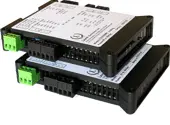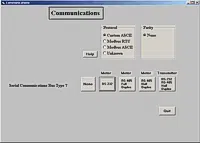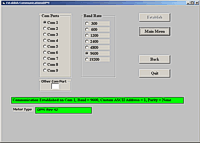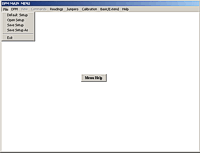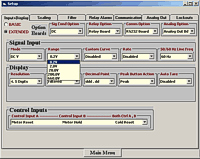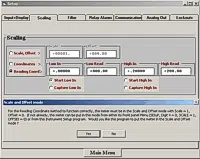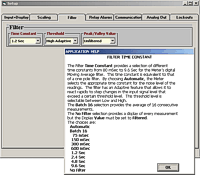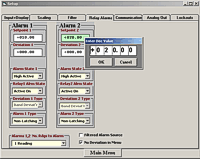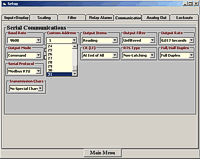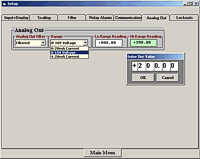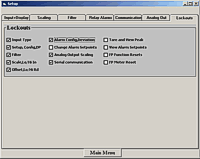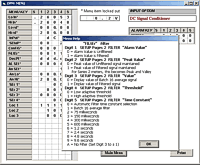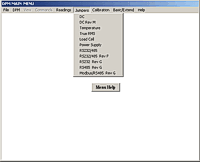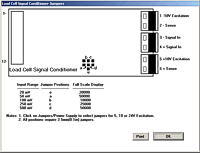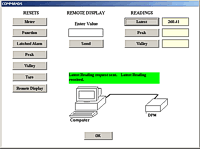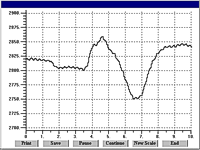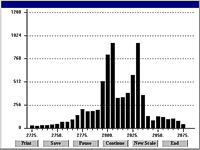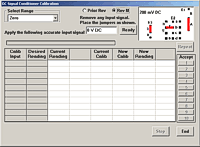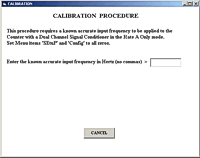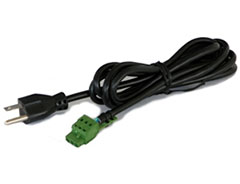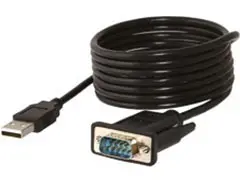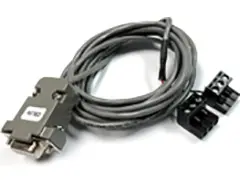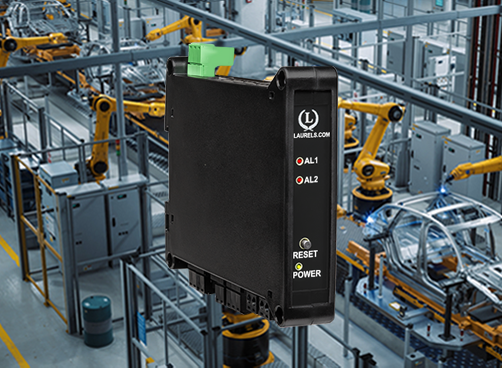
Features
- ±0.2, ±2, ±20, ±200, ±300V and ±600V voltage input ranges
- ±2, ±20, ±200 mA and ±5A current input ranges.
- Accuracy ±0.01% of reading ± 2 counts
- All input ranges are user selectable and factory calibrated
- Up to 60 conversions per second, Ideal for peak or valley capture
- 4-20 mA, 0-20 mA, 0-10V or -10V to +10V transmitter output, (isolated)
- Analog output resolution 0.0015% of span, accuracy ±0.02% of span
- Ethernet data I/O, Modbus TCP
- Dual 120 mA solid state relays for alarm or control (isolated)
- 5V, 10V, 12V, or 24V dc transducer excitation output (isolated)
- Power 85-264 Vac / 90-300 Vdc or 10-48 Vdc / 12-32 Vac (isolated)
- DIN rail mount housing, 22.5 mm wide, detachable screw-clamp connectors
- Operating temperature from -40°C to 70°C (-40°F to 158°F)
Optional - Extended allows up to 180 data points for custom curve linearization and a rate derived from consecutive readings.
The Laureate™ LTE Series DIN rail analog transmitter with ethernet communication and analog outputs for versatile connectivity.
The digitally programmable transmitter features two relays for alarm or control. The series offers exceptional accuracy of 0.01% of reading ± 2 counts, with high read rates at up to 60 or 50 conversions per second. The LTE Series transmitters offer the same high performance, signal conditioning, and programmable features as Laureate digital panel meters, counters, and timers.The Laureate 4-20 mA, 0-20 mA, 0-10V or -10V to +10V and ethernet output transmitter for DC voltage and current inputs:
- DC voltmeter operation (selected by jumpers) provides and six full-scale DC voltage ranges from ±200.00 mV with 10 mV resolution to ±600.0V with 100 mV resolution. The 200.00 mV and 2.0000V ranges provide a high input impedance of 1 Gohm to minimize the load on the voltage signal.
- DC ammeter operation (selected by jumpers) provides four full-scale DC current ranges from ±2.0000 mA with 0.1 mA resolution to ±5.000 A with 1 mA resolution. The 5.000 A range measures the IR drop across a built-in 10 milliohm current shunt.
All signal conditioner board ranges are factory-calibrated, with calibration factors for each range securely stored in an onboard EEPROM. These factors can be scaled via software to accommodate external shunts, enabling field replacement of signal conditioner boards without necessitating recalibration of the associated transmitter. For optimal accuracy, factory recalibration is recommended annually. All Laurel Electronics instruments undergo factory calibration using the industry-leading Fluke calibrators, which are recalibrated yearly and certified traceable to national standards, ensuring the highest level of precision and reliability.
The optional extended Laureate computer board enhances Laureate Transmitters by displaying rates derived from successive readings and enabling highly accurate custom curve linearization. For example, it can calculate liquid volume or flow rate in a horizontal cylindrical tank using levels from a 4-20 mA transmitter. Setup is straightforward: users input up to 180 data points into a spreadsheet or text file, and the computer calculates spline-fit segments, which are then downloaded to the transmitter for precise operation.
Laureate Transmitters are easily programmed with Laurel’s free Instrument Setup Software, downloadable from our website and compatible with Windows PCs, requiring a data interface board for setup.
High read rate of up to 50 or 60 conversions per second, the Laureate™ LTE Series transmitter uses Concurrent Slope (US Pat. 5,262,780) analog-to-digital conversion to integrate signals over a full power line cycle (50 Hz or 60 Hz). This read rate enables peak and valley capture, real-time computer interfacing, and control applications. Peak and valley values are automatically captured and can be viewed using Laurel’s free Instrument Setup Software (compatible with Windows PCs) or transmitted as serial data.
Standard Features of Laureate LTE Transmitters Include:
- Ethernet I/O, (isolated). The supported protocols are Modbus RTU and ASCII, which are tunneled via Modbus TCP. Note that RS232 or RS485 data I/O is provided by Laurel's LT Series transmitters.
- 4-20 mA, 0-20 mA or 0-10V analog transmitter output, (isolated), jumper-selectable and user scalable. All selections provide 16-bit (0.0015 ) resolution of output span and 0.02% output accuracy of a reading from -99,999 to +99,999 counts that is also transmitted digitally. Output isolation from signal and power grounds eliminates potential ground loop problems. The supply can drive 20 mA into a 500 ohm (or lower) load for 10V compliance, or 10V into a 5K ohm (or higher) load for 2 mA compliance.
- Dual solid state relays, (isolated). Available for local alarm or control. Rated 120 mA at 130 Vac or 180 Vdc.
- Selectable transducer excitation output, (isolated), user selectable 5V@100 mA, 10V@120 mA, 12V@100mA, or 24V@50 mA.
- Power 85-264 Vac, (isolated), low-voltage 10-48 Vdc or 12-32 Vac power is optional.
Digital signal filtering modes can be selected to ensure stable readings in electrically noisy environments.
- An unfiltered selection provides true peak and valley readings and aids in control applications.
- A batch average filter selection averages each 16 conversions.
- An adaptive moving average filter selection provides a choice of 8 time constants from 80 ms to 9.6 seconds. When a significant change in signal level occurs, the filter adapts by briefly switching to the shortest time to follow the change, then reverts back to its selected time constant. An auto setting selects the time constant selection based on signal noise.
Two tare functions: auto-tare and manual tare. In auto-tare, an input line is grounded by an external pushbutton. This causes the current weight, which is normally the empty weight of the container to be stored in memory as an offset. In manual tare, the tare value can be entered manually via a control input pushbutton or using Laurel's free Instrument Setup Software.
Peak and valley values are automatically captured. These may be displayed via Laurel's free Instrument Setup Software, which runs on a PC under MS Windows or can be transmitted as serial data.
An (isolated) 5, 10, 12, or 24 Vdc excitation output is standard to power transducers or two-wire transmitters. Ratiometric operation, which automatically compensates for changes in the applied excitation, is jumper selectable for applications, such as bridges, where the signal to be measured is proportional to the excitation level.
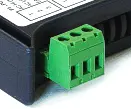
LTE series DIN rail transmitters & signal conditioners can be interfaced to a wide range of sensors and transducers using one of seven available plug-in signal conditioner boards. The transmitters duplicate the high performance (high accuracy, high read rate) and extensive programmable features of Laureate 1/8 DIN digital panel meters, counters and timers. They utilize the same signal conditioners boards, much of the same firmware, and Laurel's free Windows-based Instrument Setup Software. They come in a compact DIN rail mount package with detachable screw-clamp connectors for easy wiring.
The LTE series Transmitters accessible from this page include a 4-20 mA, 0-20 mA, 0-10V, or -10V to +10V analog output (isolated, user selectable), an ethernet serial data interface (isolated, user selectable), and dual 120 mA solid state AC/DC relays (isolated). An (isolated) 5, 10, 12, or 24 Vdc transducer excitation output is included with all models other than those with a temperature or AC RMS signal conditioner.
Connecting Laureate LTE Transmitters to a Local Area Network (LAN)
Laurel LTE series Ethernet transmitters can connect directly to a LAN via an Ethernet cable. Up to 30 Laureate LT Transmitters and/or Digital Panel Meters can be configured for RS485 and daisy-chained to an LT Transmitter for seamless LAN integration. Setup for both configurations is streamlined using Laurel’s free Instrument Setup Software, which simplifies node discovery and transmitter configuration.
Flexible Communication Options for LTE Transmitters
Laureate Transmitters can be equipped with Laurel communication boards to support various interfaces and protocols. These include serial interfaces with ASCII or Modbus RTU protocols, and Ethernet interfaces with web access, ASCII, or Modbus TCP/IP protocols, ensuring versatile connectivity for your commercial applications.
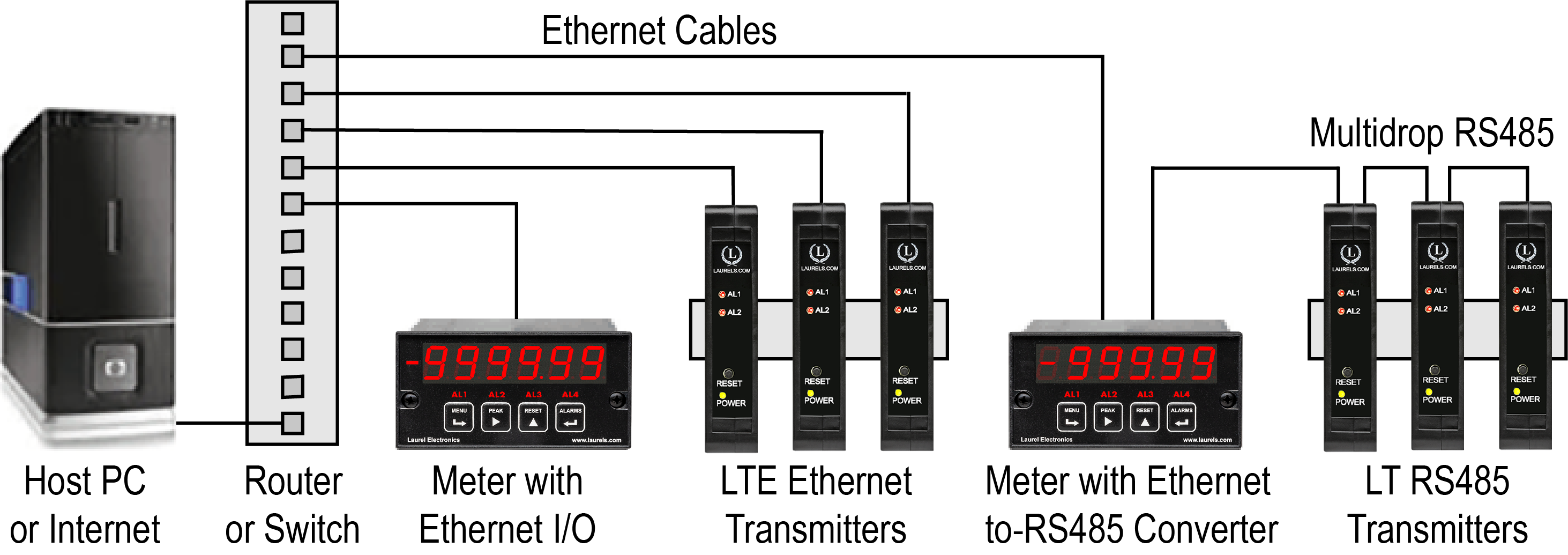
| LTE Transmitter Signal Input & Function | Model Series | Analog Output | Ethernet I/O | Dual Relays | |
|---|---|---|---|---|---|
| 1 | DC Input Voltage and Current | LTE-DC |  |
 |
 |
| 2 | AC RMS Voltage or Current | LTE-RMS |  |
 |
 |
| 3 | Process Voltage or Current | LTE-P |  |
 |
 |
| 4 | Strain Gauge or Potentiometer Follower | LTE-SG |  |
 |
 |
| 5 | Weighing Applications | LTE-WA |  |
 |
 |
| 6 | Load Cell & Microvolt Signals | LTE-WM |  |
 |
 |
| 7 | Thermocouple (Types J, K, T, E, N, R, S) | LTE-TC |  |
 |
 |
| 8 | RTD Temperature | LTE-RTD |  |
 |
 |
| 9 | Resistance in Ohms | LTE-R |  |
 |
 |
| 10 | Frequency, Rate, Speed | LTE-FR |  |
 |
 |
| 11 | Pulse Input Totalizer | LTE-FR |  |
 |
 |
| 12 | Process Signal Totalizer | LTE-VF |  |
 |
 |
| 13 | Batch Controller Analog Input | LTE-FR |  |
 |
 |
| 14 | Batch Controller Pulse Input | LTE-FR |  |
 |
 |
| 15 | Sum, Difference, Ratio, Product of 2 Inputs | LTE-FR |  |
 |
 |
| 16 | On/Off Duty Cycle | LTE-FR |  |
 |
 |
| 17 | Stopwatch Timing for Single Events | LTE-FR |  |
 |
 |
| 18 | Average Time of Periodic Events | LTE-FR |  |
 |
 |
| 19 | AC Phase Angle and Power Factor | LTE-FR |  |
 |
 |
| 20 | Quadrature Position or Rate | LTE-QD |  |
 |
 |
DC voltage input signal transmitter
| Analog Input | Range | Resolution | Accuracy | Input Ohms |
|---|---|---|---|---|
| DC Voltage | ±200.00 mV | 10 µV | 0.01% FS ± 2 cts | 1 GΩ |
| ±2.0000 V | 100 µV | 0.01% FS ± 2 cts | 1 GΩ | |
| ±20.000 V | 1 mV | 0.01% FS ± 2 cts | 10 MΩ | |
| ±200.00 V | 10 mV | 0.01% FS ± 2 cts | 10 MΩ | |
| ±600.0 V* | 100 mV | ± 0.4 V | 10 MΩ | |
| * Range ETL certified to ±300.0 V | ||||
DC Current input signal transmitter
| Analog Input | Range | Resolution | Accuracy | Input Ohms |
|---|---|---|---|---|
| DC Current | ±2.0000 mA | 0.1 µA | 0.01% FS ± 2 cts | 100 Ω |
| ±20.000 mA | 1 µA | 0.01% FS ± 2 cts | 10 Ω | |
| ±200.00 mA | 10 µA | 0.01% FS ± 2 cts | 1 Ω | |
| ±5.000 A | 1 mA | ±10 mA | 0.01 Ω | |
| Recalibration: All ranges are calibrated at the factory. Recalibration is recommended every 12 months. | ||||
| Recalibration: All ranges are calibrated at the factory. Recalibration is recommended every 12 months. | ||||
| Input Resolution | 16 bits (65,536 steps) | |||
| Update Rate, Max | 50/sec at 50 Hz, 60/sec at 60 Hz | |||
| Max applied voltage | 600 Vac for 20, 200 & 600 V ranges, 125 Vac other ranges | |||
| Over-current protection | 25x for 2 mA, 8x for 20 mA, 2.5x for 200 mA, 1x for 5 A | |||
| Analog Output (standard) | ||||
|---|---|---|---|---|
| Output Levels | 0-20 mA or 0-10 Vdc (selectable) | |||
| Compliance, 4-20 mA | 10V (0-500Ω load) | |||
| Compliance, 0-10V | 2 mA (5 kΩ load) | |||
| Output Resolution | 16 bits (65,536 steps) | |||
| Output Accuracy | 0.02% of output span plus conversion accuracy | |||
| Output Isolation | 250V rms working, 2.3 kV rms per 1 minute test | |||
| Ethernet Data I/O (standard) | ||||
| Type | 10/100 Base-T Ethernet per IEEE 802.3 | |||
| Data Rates | 300, 600, 1200, 2400, 4800, 9600, 19200 baud | |||
| Output Isolation | 250V rms working, 2.3 kV rms per 1 min test | |||
| Serial Protocols | Modbus TCP | |||
| Modbus Compliance | Modbus over Serial Line Specification V1.0 (2002) | |||
| Digital Addresses | 247 | |||
| Dual Relay Output (standard) | ||||
| Relay Type | Two solid state relays, SPST, normally open, Form A | |||
| Load Rating | 120 mA at 140 Vac or 180 Vdc | |||
| Excitation Output (standard) | ||||
| 5 Vdc | 5 Vdc ± 5%, 100 mA (jumper selectable) | |||
| 10 Vdc | 10 Vdc ± 5%, 120 mA (jumper selectable) | |||
| 12 Vdc | 12 Vdc ± 5%, 100 mA (jumper selectable) | |||
| 24 Vdc | 24 Vdc ± 5%, 50 mA (jumper selectable) | |||
| Output Isolation | 50 Vdc from signal ground | |||
| Power Input | ||||
| Standard Power | 85-264 Vac or 90-300 Vdc | |||
| Low Power Option | 10-48 Vdc or 12-32 Vac | |||
| Power Frequency | DC or 47-63 Hz | |||
| Power Isolation | 250V rms working, 2.3 kV rms per 1 min test | |||
| Power Consumption | 2.5W typical at 24V, 4.0W with max excitation output | |||
| Environmental | ||||
| Operating Temperature | -40°C to 70°C (-40°F to 158°F) | |||
| Storage Temperature | -40°C to 85°C (-40°F to 185°F) | |||
| Relative Humidity | 95% at 40°C, non-condensing | |||
| Cooling Required | Mount transmitters with ventilation holes at top and bottom. Leave 6 mm (1/4") between transmitters, or force air with a fan. | |||
| Mechanical | ||||
| Enclosure | Rugged black polycarbonate housing material | |||
| Mounting | 35 mm rail per DIN EN 50022 | |||
| Dimensions | 129 x 104 x 22.5 mm case | |||
| Connectors | Detachable screw clamp connectors meet VDE / IEC / UL / CSA standards. RJ45 jack for Ethernet | |||
| Tightening Torque | Screw terminal connectors: 5 lb-in (0.56 Nm) | |||
| Weight | Complete transmitter: 183 g (6.5 oz) | |||
| General | ||||
| Programming | Utilize Laurel's free Instrument Setup Software, which runs on a PC under MS Windows. | |||
| Security | Lockout options available using Laurel's free Instrument Setup Software. | |||
| Warranty | 3 years parts & labor | |||
| Recalibration: All ranges are calibrated at the factory. Recalibration is recommended every 12 months. | ||||
Transmitter Pinout
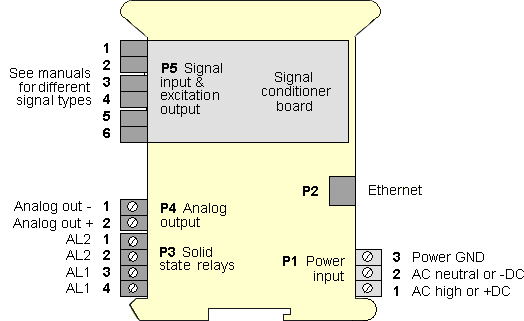
Free Instrument Setup Software for Series 2 Laureates
Free Downloadable Windows-based Instrument Setup (IS) software (Data Interface Board Required) for use with our programmable Digital Panel Meters, Scale Meters, Counters, Timers, Remote Displays, and Transmitters, are an easy method to set up Laureate 1/8 DIN digital panel meters, counters, timers, remote displays, and DIN-rail transmitters, as explained in the Instrument Setup Software Manual. Laureate 1/8 DIN instruments can also be set up from the front panel, as explained in their respective Owners Manuals. Instrument Setup software is of benefit whether or not the PC is connected to the instrument.
- When the PC is connected to the instrument, Instrument Setup software can retrieve the setup file from the instrument or open a default setup file or previously saved setup file from disk View Setup, then provides graphical user interface (GUI) screens with pull-down menus applicable to input, display, scaling, filtering, alarms, communications, analog output, and front panel lockouts. Fields that are not applicable to the instrument as configured are either left out or grayed out. Clicking on any item will bring up a detailed Help screen for that item. After editing, the setup file can be downloaded, uploaded to the instrument, or saved to a disk. The same setup file can then be downloaded into multiple instruments.
- When the PC is not connected to the instrument, the above GUI screens can be used to set up a virtual instrument. The setup file can then be saved to disk. Switching toView Menu then brings up a screen with the required front panel programming steps. This view can be printed out for use at the instrument site and to serve as a hard copy record.
Download Free Instrument Setup Software
Installation
Set User Account Control (UAC) of MS Windows to "Never notifiy me" so that Instrument Setup Software can create directories. The UAC change screen can be reached as follows:
- Under Windows 7, click on the Windows Start button in the lower left of the desktop and enter "UAC" in the search field.
- Under Windows 8, navigate to Control Panel, then to the "User Accounts and Family Safety" section, and click on "Change User Account Control Settings."
- Under Windows 10, click on the Windows Start button in the lower left of the desktop, then on "Settings", and enter "UAC" in the search field.
- Reboot your computer for the changed UAC setting to take effect.

RJ11-to-DB9 cable with rear view of DB9 connector to PC
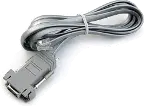
RS232 cable, meter to PC, P/N CBL01
Laureate 1/8 DIN Laureate instruments must be equipped with a serial communications board and be connected to the computer via a serial communications cable. The connection can be via RS232, RS485, USB or Ethernet. Following setup, the serial communications board may be removed from the instrument if desired. The wiring of the RS232 cable is illustrated above with end views of the two connectors.
Laureate LT Series transmitters come standard with a 3-wire serial interface, which can be jumpered for RS232 or RS485.
Laureate LTE Series transmitters come standard with an Ethernet interface.
Meter Setup Screens
Click on any of the reduced screens below for a full-size screen view, then click on the Back button of your browser to return to this page. The screens examples below are for a fully-loaded Series 2 Digital Panel Meter (DPM), which is connected to the PC via RS232. If the meter is a Series 1 meter (pre-2007), this is sensed by the software, and somewhat different screens are brought up. Please see Series 1 setup screens.











Meter Setup Utilities




From the Main Menu, click on Readings if your PC is connected to the meter. A pull-down menu then offers three choices: List, Plot and Graph.
- List presents the latest readings in a 20-row by 10-column table. Press Pause at any time to freeze the display. This is one method to capture peak readings.
- Plot generates a plot of readings vs. time in seconds. It effectively turns the DPM-PC combination into a printing digital oscilloscope.

- Graph generates a histogram where the horizontal axis is the reading and the vertical axis is the number of occurrences of readings. The display continually resizes itself as the number of readings increases.



Dimensions
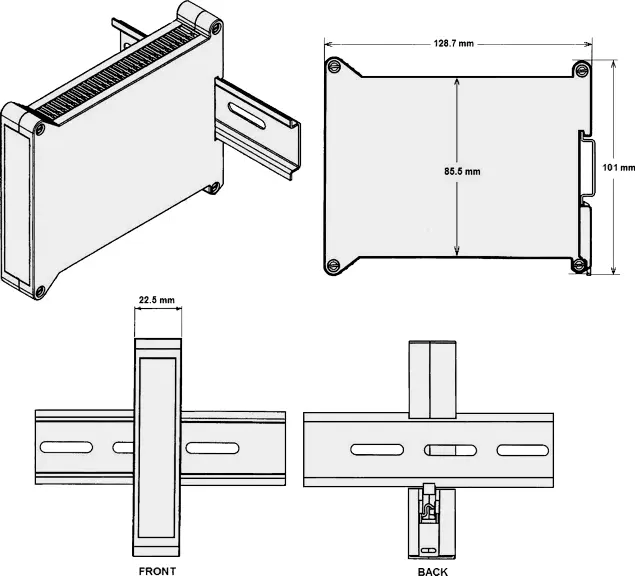
Dimensioned CAD assembly drawings in EPRT, STEP, x_t, .dwg, pdf file formats: Laureate-transmitter-case.zip (zipping prevents browser from opening CAD files as text files).
CBL02
USB-to-RS232 Adapter Cable
CBL04
RS232 Cable for LT Transmitters
What is an LTE Series DIN Rail Analog Transmitter with Ethernet Communication and Analog Outputs for DC Voltage Input Signal?
In modern industrial automation and control systems, accurate signal transmission is essential for monitoring and controlling various processes. An LTE Series DIN Rail Analog Transmitter is a device specifically designed to convert DC voltage input signals into standardized analog outputs while also offering Ethernet communication capabilities. This combination of features makes it a versatile and powerful tool for industrial applications.
Overview of the LTE Series DIN Rail Analog Transmitter
An LTE Series DIN Rail Analog Transmitter is a device that is mounted on a DIN rail, a standardized mounting system used in control cabinets and enclosures. The DIN rail design ensures easy installation and integration into existing systems, making it a popular choice in industrial settings.
Key Features
- DC Voltage Input Signal:
- The transmitter is designed to accept DC voltage input signals. These signals typically originate from sensors, transducers, or other devices that measure various parameters such as temperature, pressure, or flow.
- The input voltage range can vary depending on the specific model, allowing it to be tailored to different application requirements.
- Analog Outputs:
- One of the primary functions of the LTE Series DIN Rail Analog Transmitter is to convert the DC voltage input into a standardized analog output.
- Common analog output types include 4-20mA current loops or 0-10V voltage signals, which are widely used in industrial automation for transmitting data over long distances with high accuracy.
- Ethernet Communication:
- In addition to analog outputs, the transmitter is equipped with Ethernet communication capabilities.
- Ethernet allows for real-time data transmission to supervisory control and data acquisition (SCADA) systems, programmable logic controllers (PLCs), or other networked devices.
- This feature enables remote monitoring, control, and configuration, enhancing the overall efficiency and flexibility of the automation system.
- Precision and Reliability:
- The LTE Series transmitter is designed with high precision in mind, ensuring accurate signal conversion and transmission.
- It is also built to withstand harsh industrial environments, with robust construction and protection against electrical noise and interference.
- Scalability:
- The Ethernet communication feature allows for easy integration into larger networks, making it a scalable solution for expanding industrial systems.
- Multiple transmitters can be networked together, providing a comprehensive monitoring and control system.
Applications
The LTE Series DIN Rail Analog Transmitter with Ethernet Communication and Analog Outputs is suitable for a wide range of industrial applications, including:
- Process Control: Monitoring and controlling various processes in manufacturing, chemical plants, and refineries.
- Energy Management: Managing and monitoring power distribution and consumption in energy systems.
- Environmental Monitoring: Collecting data from environmental sensors and transmitting it to centralized monitoring systems.
- Building Automation: Controlling HVAC systems, lighting, and other building infrastructure.
Conclusion
The LTE Series DIN Rail Analog Transmitter with Ethernet Communication and Analog Outputs for DC Voltage Input Signal is a powerful tool for industrial automation. Its ability to convert DC voltage inputs into standardized analog outputs, combined with Ethernet communication, makes it an ideal choice for applications requiring precise signal transmission, remote monitoring, and scalability. Whether used in process control, energy management, or environmental monitoring, this transmitter is a reliable and versatile solution that meets the demands of modern industrial systems.
Where is an LTE Series DIN Rail Analog Transmitter with Ethernet Communication and Analog Outputs for DC Voltage Input Signal Used?
In today's rapidly evolving industrial landscape, efficient signal transmission and processing are critical. The LTE Series DIN Rail Analog Transmitter with Ethernet communication and analog outputs for DC voltage input signals is a versatile device that plays a crucial role in various applications. This article will explore where and how this technology is utilized.
1. Industrial Automation
In industrial automation, accurate signal transmission is essential for the smooth operation of processes. The LTE Series DIN Rail Analog Transmitter is widely used in these environments to convert DC voltage input signals from sensors or transducers into standardized analog outputs. This allows for precise monitoring and control of various processes, such as temperature, pressure, and flow rates.
The Ethernet communication feature is particularly valuable in industrial automation, as it enables remote monitoring and data acquisition. This capability allows operators to access real-time data from multiple transmitters across different locations, ensuring that processes remain within desired parameters. This connectivity also facilitates integration with supervisory control and data acquisition (SCADA) systems, enhancing overall efficiency and reliability.
2. Energy Management Systems
Energy management is another area where the LTE Series DIN Rail Analog Transmitter shines. In power plants, substations, and renewable energy installations, this device is used to monitor DC voltage levels from various sources, such as solar panels, batteries, or power supplies. The transmitter converts these signals into analog outputs that can be easily interpreted by energy management systems.
The Ethernet communication feature allows for seamless integration with energy monitoring software, enabling real-time data analysis and reporting. This capability is crucial for optimizing energy consumption, detecting anomalies, and ensuring the efficient operation of power generation and distribution systems.
3. Building Automation Systems
Modern building automation systems (BAS) rely on precise data from various sensors to maintain optimal environmental conditions. The LTE Series DIN Rail Analog Transmitter is commonly used in these systems to process DC voltage signals from sensors monitoring temperature, humidity, light levels, and occupancy.
With its Ethernet communication capabilities, the transmitter can easily be integrated into a building's network, allowing facility managers to monitor and control conditions remotely. This feature is particularly useful in large buildings or campuses where centralized control is necessary for maintaining comfort and energy efficiency.
4. Process Control in Manufacturing
Manufacturing processes often require precise control of various parameters, such as voltage, current, temperature, and pressure. The LTE Series DIN Rail Analog Transmitter is essential in converting DC voltage signals from process sensors into analog outputs that can be used by controllers and other equipment.
In addition to analog outputs, the transmitter's Ethernet communication feature enables real-time data sharing across different parts of the manufacturing facility. This ensures that all components of the process are synchronized, reducing the risk of errors and improving overall production quality.
5. Remote Monitoring and Telemetry
In remote monitoring and telemetry applications, the LTE Series DIN Rail Analog Transmitter is used to gather data from sensors located in hard-to-reach or hazardous environments. These sensors often output DC voltage signals, which the transmitter converts into analog signals for further processing.
The Ethernet communication capability allows the transmitter to send data over long distances to a central monitoring station. This is particularly useful in applications such as environmental monitoring, oil and gas exploration, and infrastructure management, where timely data acquisition is critical for making informed decisions.
6. Laboratory and Research Environments
In laboratories and research facilities, the LTE Series DIN Rail Analog Transmitter is used to process DC voltage signals from various experimental setups. The analog outputs provided by the transmitter can be used to interface with data acquisition systems, control equipment, or other instrumentation.
The Ethernet communication feature allows researchers to remotely monitor and control experiments, making it easier to manage complex setups or conduct long-term studies. This capability is especially valuable in situations where experiments need to be monitored continuously or where environmental conditions must be tightly controlled.
Conclusion
The LTE Series DIN Rail Analog Transmitter with Ethernet communication and analog outputs for DC voltage input signals is a versatile and essential device in a wide range of applications. Whether in industrial automation, energy management, building automation, manufacturing, remote monitoring, or research, this transmitter provides accurate signal conversion and reliable communication, ensuring optimal performance and efficiency in various systems. Its ability to integrate with modern digital networks makes it an indispensable tool in the age of Industry 4.0 and beyond.
Less Information.








